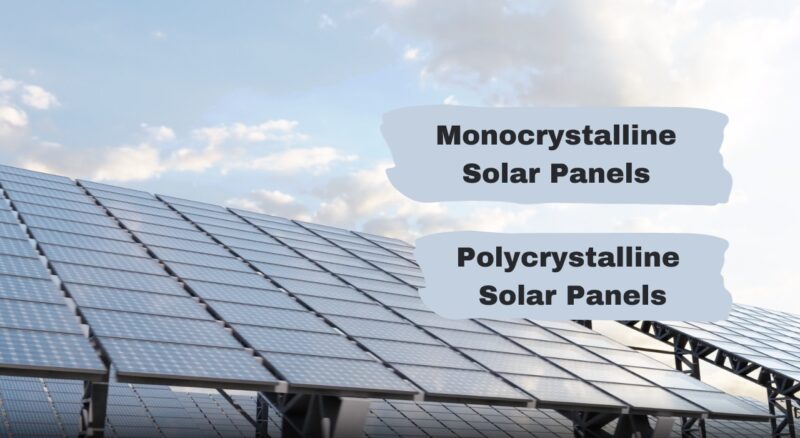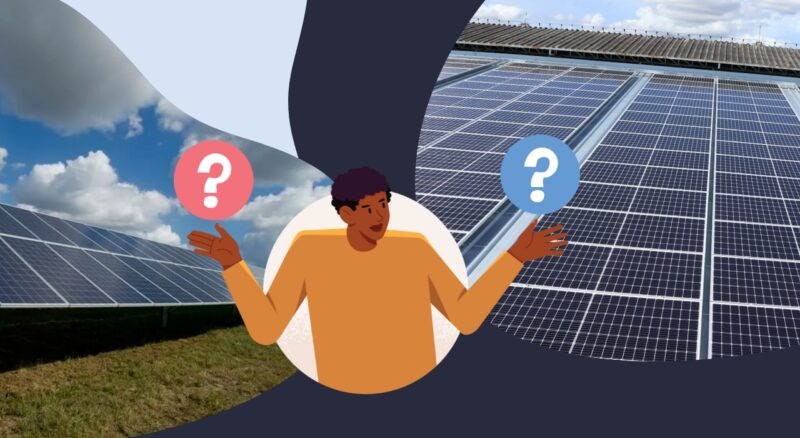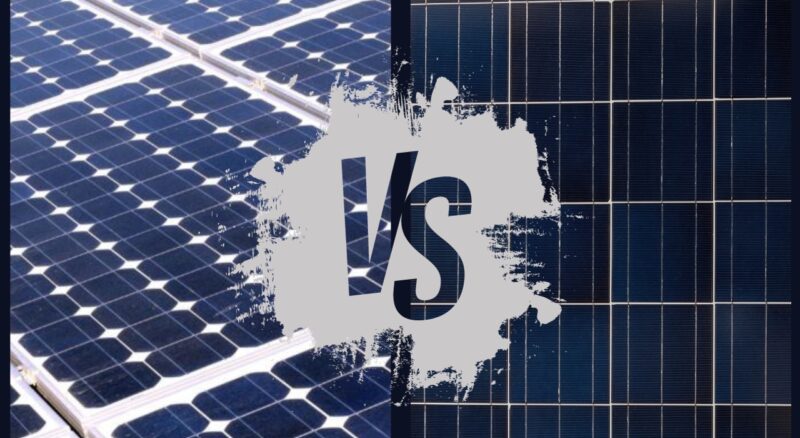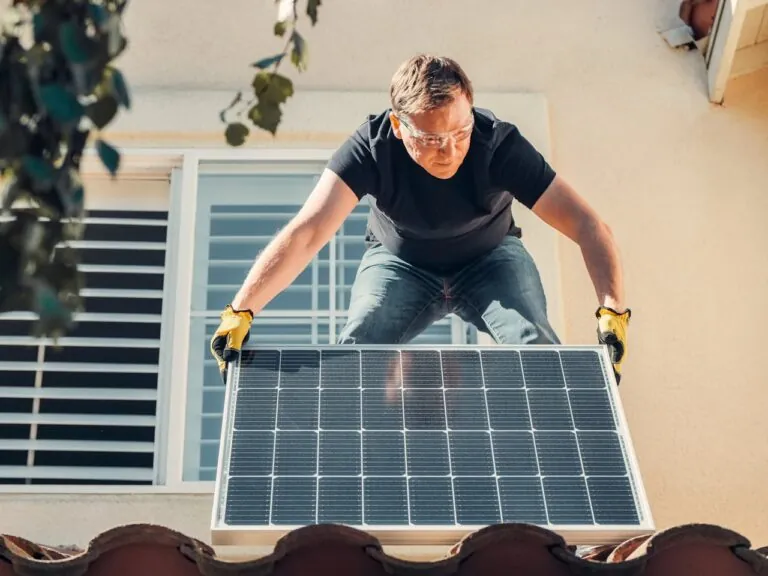Imagine standing in a candy store, trying to decide between two different types of chocolate bars. At first glance, both seem pretty similar – after all, they’re both chocolate!
But, as any chocolate aficionado might tell you, the type of cocoa, the process of making it, and other small details can greatly affect the taste, texture, and overall experience.
Similarly, when you’re considering solar panels for your home or business, you’ll come across two primary types: monocrystalline and polycrystalline. Although they might seem quite alike, they have their unique characteristics and benefits.
In this discussion, we’ll explore these differences, making it easier for you to make an informed choice, just like choosing that perfect chocolate bar.
Main Features of Solar Panels

Solar panels are incredible pieces of technology that turn sunlight into electricity. The better they do this job, the more energy and money you save.
How Do They Work?
They are made up of individual solar cells, which are essentially the building blocks of the panel. These cells capture sunlight and convert it into electricity through a process called the photovoltaic effect.
The efficiency of this conversion is critical, and the type of solar cell plays a pivotal role. Photons from the sun strike the solar cells, releasing electrons from their atoms. When these electrons move, they create an electric current which is then used to power our homes or businesses.
The effectiveness of this process is influenced by the purity and arrangement of the silicon used in the cells.
Types of Solar Panels

There are primarily three types of solar panels available in the market: Monocrystalline, Polycrystalline, and Thin-Film. For the purpose of our discussion, we’ll be focusing on the first two, as they’re the most common for residential and commercial use.
Monocrystalline Solar Panels
These are the “original” solar panels, having been around since the early days of solar energy. Known for their dark black hue, they have a distinct look and some unique properties.
Characteristics and Benefits
| Feature | Description |
|---|---|
| Cell Structure | Single crystal structure |
| Color/Appearance | Black or dark blue; uniform appearance |
| Cell Shape | Typically octagonal or rounded edges |
| Thickness | Varies, but often around 200 micrometers |
| Size | Commonly 156mm x 156mm, but can vary |
| Frame | Usually made of aluminum |
| Backsheet | Typically white or black |
| Glass | Anti-reflective, tempered glass |
| Efficiency | Higher than polycrystalline; often 15-22% |
| Temperature Coefficient | Typically around -0.3% to -0.5% per °C |
| Longevity | 25+ years with minimal degradation |
Monocrystalline panels are made from a single crystal structure, which means they’re composed of cells derived from a single pure silicon crystal. This uniformity gives them an edge in efficiency. They tend to have a higher power output, require less space, and last longer.
Their lifespan can easily exceed 25 years, making them a popular choice for long-term investments. Thanks to the purity and the production method, these can yield a higher efficiency rate, often between 15-20%.
This means for every 100 watts of sunlight that hits them, they can produce 15-20 watts of electricity. This high efficiency can be particularly beneficial for those with limited roof space. Proper selection of size is essential as well, and it depends on your budget, available surface, and needs.
Drawbacks and Considerations
The primary downside of monocrystalline panels is the cost. The production process, known as the Czochralski method, involves melting silicon in a crucible and drawing out a single crystal seed, resulting in the formation of large, cylindrical crystals.
This method is more expensive, and as a result, so are the panels. Additionally, they can sometimes underperform in high heat. Their performance can drop as temperatures rise, though this is a trait shared with many solar panels.
Polycrystalline Solar Panels
Polycrystalline panels are a newer technology compared to their monocrystalline counterparts. They have a distinct blueish hue due to the way they scatter light.
Key Features
| Feature | Description |
|---|---|
| Cell Structure | Made up of multiple small crystals or cells. |
| Color/Appearance | Blueish hue due to the light scattering from multiple crystal grains. |
| Thickness of the Wafer | Typically around 200 micrometers. |
| Size | Standard sizes include 60-cell and 72-cell panels, but can vary. |
| Frame | Usually made of aluminum, providing structural support. |
| Front Glass | Tempered glass to protect the cells and improve durability. |
| Backsheet | Layer at the back of the panel to protect and insulate the cells. |
| Junction Box | Attached to the back, housing the electrical components. |
| Efficiency | Typically ranges from 15% to 18%, but can vary based on the manufacturer and technology advancements. |
| Weight | Varies based on size and frame, but a standard 60-cell panel might weigh around 18-25 kg. |
| Lifespan | Generally 25-30 years, with a gradual decrease in efficiency over time. |
Unlike monocrystalline panels, these are made from multiple silicon fragments melted together. This process is more straightforward and cost-effective, leading to cheaper panels. For those on a budget, polycrystalline offers a more affordable entry into solar energy.
Their efficiency is slightly lower, usually hovering between 13-16%. While this is a step down from monocrystalline, it’s still respectable and can offer good energy production, especially in areas with consistent sunlight.
Potential Limitations
The main drawback of polycrystalline panels is their lower efficiency. If roof space is a premium, you might find that you need more panels to achieve the same energy output as fewer monocrystalline panels.
Additionally, because they’re made from multiple silicon crystals, their lifespan might be slightly shorter, though they can still last upwards of 20 years with proper care. Their aesthetic is also something to consider.
The blueish hue might not be to everyone’s taste, and if the look of your solar installation is essential, this is a point worth noting.
How to Make the Right Choice?

Both monocrystalline and polycrystalline solar panels have their strengths and weaknesses. Your choice will largely depend on your specific needs, budget, and aesthetic preferences.
| Criteria | Polycrystalline Panels | Monocrystalline Panels |
|---|---|---|
| Cost | More affordable upfront | Higher initial cost |
| Efficiency | Lower efficiency | Higher efficiency |
| Long-term ROI | Respectable energy production | Better long-term return on investment |
| Aesthetics | Blue hue | Sleek black look |
| Space Efficiency | Requires more panels for the same output | More energy from fewer panels due to efficiency |
| Recommended for | Budget-conscious buyers | Buyers looking for best long-term ROI & aesthetics |
FAQs
What Are the Primary Materials Used in These Solar Panels?
Both monocrystalline and polycrystalline solar panels are primarily made from silicon. Monocrystalline panels are made from single-crystal silicon, while polycrystalline panels are made from melted fragments of silicon crystals.
Are There Significant Maintenance Differences?
Generally, both types of panels require minimal maintenance. Cleaning them a few times a year to remove dust and debris is usually sufficient. However, always refer to the manufacturer’s guidelines for specific care instructions.
Is There a Significant Difference in The Degradation Rate?
All solar panels degrade over time, losing some of their efficiency. On average, solar panels lose about 0.5% of their efficiency each year. While monocrystalline panels typically have a slightly slower degradation rate due to their purity, the difference is minimal and might not be significant over a typical panel’s lifespan.
Can I Mix and Match Monocrystalline and Polycrystalline Panels in A Solar Installation?
Technically, yes, you can mix different types of panels. However, it’s essential to ensure that they have compatible voltage, wattage, and are connected using the correct inverter and charge controller settings.
For optimal performance and ease of installation, it’s generally recommended to use panels of the same type and from the same manufacturer.
How Do These Panels Perform in Cloudy Conditions?
While both types will see a reduction in efficiency in cloudy conditions, they still produce energy. Monocrystalline panels might have a slight edge in low-light conditions due to their higher overall efficiency, but the difference is often minimal.
Investing in a good quality panel and ensuring proper installation are crucial factors for performance in varied weather conditions.
Are There Any Environmental Concerns in The Production of Either Type of Panel?
The production of both monocrystalline and polycrystalline solar panels requires energy and resources. Monocrystalline panels, due to their complex production process, might have a slightly higher carbon footprint initially.
However, given the long lifespan of solar panels and the clean energy they produce, the environmental benefits they provide over their lifetime far outweigh the initial environmental costs of production. Always look for manufacturers who follow sustainable and eco-friendly practices.
The Bottom Line
Choosing between monocrystalline and polycrystalline solar panels can feel a bit like our chocolate bar dilemma: both have their merits, and the best choice often depends on individual preferences and circumstances.
After exploring their differences, it’s clear that there isn’t a one-size-fits-all answer. Just as some people savor the richness of dark chocolate while others relish the sweetness of milk chocolate, your ideal solar panel choice will depend on factors like your budget, aesthetic preferences, and space considerations.
Regardless of your choice, you’re making a commendable step towards a more sustainable future.












